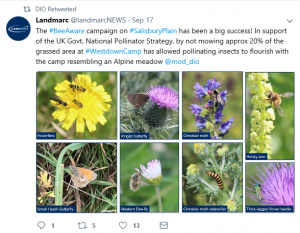The other day, I spotted a Tweet by Landmarc (who provide estate management for much of the defence estate), celebrating the success of grassland management on part of the British Army’s training area at Salisbury Plain, in terms of the government’s National Pollinator Strategy:
This got me thinking about some research I did, many years ago now, on the intersections between military land use and environmental protection (see here and here). That work feels very dated now, and seeing Landmarc’s celebration of its habitat management strategies, I’ve been thinking about why that is, and what has changed.
The most obvious change is that it is now really widely recognised that much of the UK defence estate consists of sites with rich and diverse ecosystems and habitats. The reason for this scale of habitat protection is fairly obvious: military land uses tend to include activities which may be dangerous to those not involved, or may require a certain amount of space and privacy. Designating land for military purposes generally means that other land uses are either entirely absent (such as intensive agriculture, housing development, significant public infrastructure), or are present but at a modest scale (upland low-intensity sheep farming would be a case in point). Given that activities such as intensive agriculture, urban development or other types of construction can have hugely negative impacts on environments and habitats, by default because military land uses block these activities, much of the defence estate has a far richer and more diverse range of habitats, flora and fauna than equivalent ground beyond the perimeter wire. Habitats (and their inhabitants) that may be rare, threatened or otherwise absent elsewhere can thrive on the defence estate. There has been considerable proactivity around this on the estate. Conservation Officers (first established in the early 1970s) have long been active on many military installations, and Sanctuary (now up to issue 46 and published by the Defence Infrastructure Organisation) through its long print run tells a story of places where there is some kind of harmony between military land uses and environmental protection as a consequence of land use strategies and practices. The environmental health of the defence estate is widely recognised now, in ways it probably wasn’t 20 years ago, because defence land management practitioners have been adept at spreading what is by any measure a positive message.
The original research that I did on military environmentalism was done in the late 1990s and the defence and security context was of course quite different then (and this was also a time when the idea of environmental security as a legitimate military concern was barely mentioned). I’m wondering now whether my original analysis about the ways in which we could understand the defence estate and military environmentalism still holds. I’m assuming that, for example, reduced personnel numbers, different equipment capabilities and altered training patterns will all have had an effect on the ways military environmentalist discourses and practices are mobilised. The management regimes will have changed, not least because serving military personnel no longer do much of the defence estate’s regular management: as the above Tweet shows, Landmarc is a key player in defence estate matters now, and I wonder what changes this has brought to land management practices. I don’t know with precision (because I haven’t asked anyone recently) how these and other defence changes have filtered through into shifts in the organisation and management of training on the UK defence estate. Neither do I know what this has meant for the habitats concerned. I suspect that there have been quite significant changes in defence estate management practices, but that very little has changed on the ground – I was up on the Otterburn ranges fairly recently, and apart from some bits of infrastructure, it looks much as it did when I first went up there more than 20 years ago. Environmental protection continues, in other words.
The flip-side of celebratory comments about the protections afforded to habitats by defence use was always an issue around environmental contamination. What does the rich environmental heritage of the defence estate hide? What about the toxic effects of military training – fuel spills, the emissions from weapons, the contamination from heavy vehicles, from military testing? In other words, what lurks beneath the greenery? I’m fairly sure that this issue hasn’t disappeared, that although there may be defence sites where remediation for past pollution and contamination has taken place, that there are also many others where the ground is potentially quite toxic. How would we know, though? There is little on public record which suggests detailed studies of this (but give me a shout if you know of any).
In thinking about what has changed over the years in terms of military environmental issues, I’m also thinking about the future for these lands. I won’t go into detail here about the future size of the defence estate, and questions about whether its current size (about 1% of the land area of the UK) can still be justified – that’s a contentious issue, an important one, but for another blog post. But, if there were to be a move towards the demilitarisation of parts of the rural estate, what issues does that then raise? David Havlick’s excellent Bombs Away: Militarization, Conservation, and Ecological Restoration is a really useful guide for thinking about this. In the book, David carefully unpicks the complex and often politically fraught practices around the ecological restoration of former military sites, primarily in the USA. He reminds us that celebrating the biodiversity of current and former military lands is only part of the story; there is always a politics at play here in these hybrid spaces where ecological processes, scientific practices and political discourses come together in transformative ways. So let’s celebrate the bees buzzing happily in the grasses of Westdown Camp – but be mindful that this is only part of a much more complex and often quite difficult military environmental story.
Rachel Woodward
